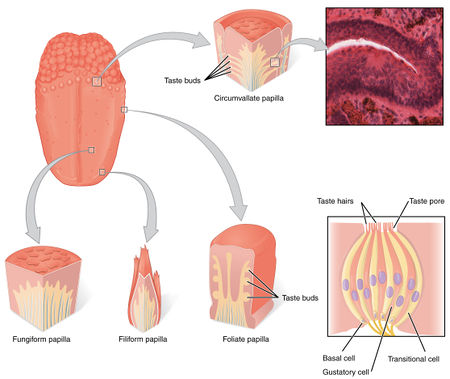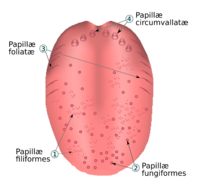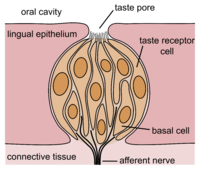Taste bud
Taste and smell go hand in hand because, without the ability to use smell, the ability to taste diminishes immensely. Taste and smell are an important aspect of life because it gives us both pleasure and sustainability. Without taste, humans would eat for the purpose of living, rather than pleasure and comfort. Without smell, we would not be able to taste or savor the food itself. Although humans could live without taste or smell, there would be no way of detecting a danger because both taste and smell detect whether something is good or bad to eat. All of our five senses are important; however, some are more important than others. Our sense of taste and smell is a somewhat superficial function. Taste and smell are an amazing function the body provides us and is an overlooked aspect of our bodies function. God gave us the ability to taste for a reason, so we can enjoy life and indulge ourselves in the pleasure of flavors.
What are Taste buds?
Taste buds are sensory organs that allow you to experience different tastes such as sweet, salty, bitter and sour. Each taste bud contains supporting cells and gustatory cells. Gustatory cells continuously regenerate, while supporting cells do not. Taste buds are found in most papillae located on the tongue. Taste buds have very sensitive, microscopic hairs called microvilli that send signals to the brain allows you to know whether a food is salty, sweet, bitter or sour.
There are different kinds of papillae located on the tongue that do different things. Fungiform papillae are found mostly at the tip and edges of the tongue. These papillae contain sensory cells for touch and temperature as well as taste. Circumvallate papillae are on the back of the tongue and are visible to the naked eye. Although there are only a few of these papillae, each one contains thousands of taste buds. Foliate papillae are located on the sides of the tongue and contain hundreds of taste buds each.[1]
Although you are never unable to experience taste, taste buds get replaced by new ones roughly every two weeks. The older you get, the harder it is for taste buds to get replaced after the cell dies, which is why older people may have more trouble distinguishing different flavors. Taste buds are not the only cells working to distinguish taste, olfactory hairs also need to be mentioned. Chemicals from the food you are eating travel up the nose which then sends signals to the olfactory hairs which use the stimulus to detect different flavors. [2]
Process of Tasting
Taste buds alone, do not give us the full experience of taste. Along with taste buds, olfactory hairs need to be included in the process. Taste buds first recognize the taste and then generates a signal which is then sent to the brain. The second part of the process deals with the scent of food. The chemicals food gives off goes into the nose and creates a signal that goes from the olfactory hairs up to the brain. Another part of the process comes down to texture. Because fungiform contains sensory receptors, it can feel the food and distinguish if it is hot or cold. [3] The texture and temperature of food tells your brain if it is good to eat. If we were unable to smell through our nose or distinguish texture, we would be unable to tell if foods were god or bad to eat. When you have a cold and a stuffy nose, it is harder to taste and experience the flavor of food we eat, that is because you cannot smell well enough to tell what food group you are eating from.
Loss of Taste
There are instances of people who have lost their sense of taste. The loss of taste is a condition called ageusia. Loss of taste can happen for many reasons such as a brain injury or brain disorder. Some other ways a person can have this condition are dry mouth caused by smoking, allergies, and certain types of medications. There are over two hundred thousand people that visit doctors each year due to their inability to taste or smell. There are debates that around fifteen percent of adults have a problem with taste or smell. Because smell and taste are closely related, many people who complain about loss of taste have actually lost their scene of smell. When you have a taste disorder, there is normally an unpleasant taste in your mouth. There is a condition called hypogeusia where a person's ability to taste sweet, sour, bitter and salty is reduced. Another taste disorder is Dysgeusia, which includes a metallic, rancid taste lingers in the mouth after eating. [4]
Many people say that taste is an underrated sense, and that, to lose the sense of taste is to loose not only the enjoyment of eating, but also the enjoyment of familiar memories. Memories are closely linked to smell, so when you smell something memorable, it can trigger a memory from the past that stands out to you. "Studies have shown that people who lose their sense of smell end up more severely depressed and for longer periods of time than people who go blind," says Prof Barry C Smith, co-director and founder of the Center for the Study of the Senses. One instance of a human loosing taste is the Olympic gold medalist James Cracknell. Cracknell lost his ability to taste or smell when he suffered a brain injury when a petrol tanker hit him while he was riding his bike. [5] To loose taste, is to loose apart of life. The pleasure of taste that was once available is gone. Without taste is to go without the joy of eating.
Interesting Facts
- Because the tongue is such a vascular organ, its tissues grow at a rapid rate causing it to be the fastest healing part of the body. [6]
-The tongue is one of the hardest working muscle groups in the body along with Soleus, the heart, Gluteus Maximus, and Masseter . [7]
-The average length of an adult tongue is about ten centimeters measured from the back of the throat to the tip.[8]
Video
A good, simple video about the process of tasting.
References
- ↑ How does our sense of taste work? IQWiG (Institute for Quality and Efficiency in Health Care). Web. Last Updated on August 17, 2016.
- ↑ Dowshen, Steven. [http://kidshealth.org/en/kids/taste-buds.html Taste buds The Nemours Foundation. Web. Reviewed October 2013.
- ↑ Wlassoff, Viatcheslav. How the Sense of Taste Works? Global Neuroscience Initiative Foundation (GNIF). Web. written on December 9, 2014 .
- ↑ Taste Disorders U.S. Department of Health and Human Services. Web. Last Updated March 6, 2017. Author unknown
- ↑ Winterman, Denise Taste and smell: What is it like to live without them? BBC News Services. Web. written on 29 June 2013.
- ↑ teddgcm Burned Tongue – Why Does it Heal So Fast? LockerGnome". Web. Posted on October 11, 2010 .
- ↑ Calderone, Julia Fact or Fiction?: The Tongue Is the Strongest Muscle in the Body NATURE AMERICA, INC. Web. written on August 15, 2014.
- ↑ Klein, Sarah 8 Things You Probably Didn’t Know About Your Tongue The Huffington Post". Web. Updated Oct 13, 2014.
| ||||||||||||||||||||




